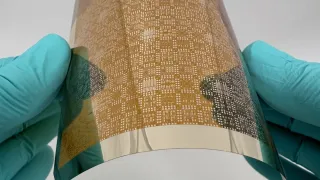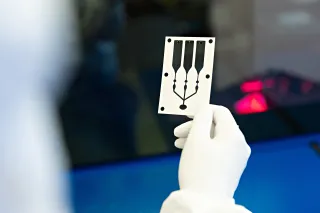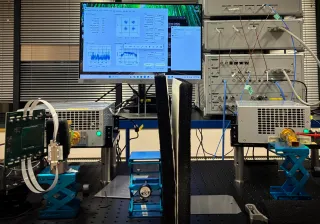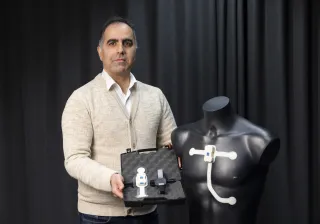Printing processes in electronics are becoming more accurate, which allows for the manufacture of small high-performance electronic structures for new applications. VTT is using Europe's most precise reverse offset printing device that can achieve an accuracy of just one micrometre. As the processes develop, printed electronics can ease the component shortage of the electronics industry and offer a new cost-effective and environmentally friendly option for the manufacture of electronics.
Printed electronics utilise the printing methods of the graphics industry in the manufacture of electronics. The printing processes are simple and cost-effective, but their accuracy and performance have put limits on the use of printed electronics. The technology is constantly being developed in an effort to meet the challenge.
VTT is in possession of Europe's most accurate reverse offset printing device for the printing of electronics. The device was acquired with support from the Academy of Finland, and it has been tested for use over the past year. The results are promising. A new printer enables considerably more accurate solutions down to just one micrometre. The technology can also be scaled for the roll-to-roll method.
Accurate printed electronics enable new applications
Printed electronics can be utilised for the manufacture of large electronic circuits for the display industry, for example. Another possible application for a large surface area is metamaterial surfaces which can be used to filter, reflect, and absorb light or electromagnetic radiation in applications of wireless communications, for example. Examples of these kinds of applications include long-range directional radio links or reflectors which improve the visibility of an object in a radar image. For example, metamaterial structures can also be used for printing colours without pigments.
Many of the potential application areas of printed electronics call for small-sized and efficient solutions. One obvious field of application involves transparent networks of conductors, or web-like structures made of conductors, whose entire surface conducts electricity. These structures are suitable for touchscreen displays, for example, or photovoltaic cells on solar panels, which turn sunlight into electrical energy.
Precision is also needed in active matrices, for example, which are used for indication in memory applications and small-sized pixel displays. Precision solutions can also be utilised in biosensors which detect small concentrations of different kinds of biomarkers, or biological factors inside the body, making it possible to measure wellness or to identify illnesses. In printed electronics it is also possible to use very thin, flexible plastic substrates with thicknesses of just a few micrometres. These kinds of substrates enable, for example, the bringing of electronics to the skin in health applications.
There is great growth potential for printed electronics in the remote identifiers of the Internet of Things and in wireless communications. These applications operate according to the standards of the field at frequencies of more than 10 MHz. Traditional printing techniques cannot be used for the manufacture of electronics operating at such high-frequency ranges. However, the necessary performance can be achieved using new precise printing techniques. However, the process needs further development if these kinds of complex circuits are to be manufactured.
Printing process reduces costs and environmental impact
The electronics industry needs increasing amounts of components that are more individualised. It is not possible to respond to the predicted demand in Internet of Things applications, for example, by using methods of the semiconductor industry without great investments. The investment costs of the printing process are lower and setting up and running the process is simpler and faster. If the same level of scalability is reached in printed electronics as it has in graphic printing, electronics can be printed in a very cost-effective manner.
Printed electronics can also reduce the environmental impact of the electronics industry. Printing processes consume less energy and materials, and they do not use strong, harmful chemicals. In addition, organic materials can be used in printed electronics, and biodegradable electronics can be made, reducing electronics waste that ends up in the environment.
Achieving cost-effectiveness and environmental benefits adds to the importance of developing printing processes. VTT's accurate printing device is a significant step in this development. The printer is already being used in many projects in the manufacture of electronics structures. This gives VTT a good position in the further development of the technology and for bringing electronics to new, significant areas of application.
Does this interest you? Read more about the possibilities offered by printed electronics in an article published in the OPE publication.
VTT Webinar: Circular design for electronics
How to design sustainable and circular electronics to fit the new EU requirements? What is required to build a techno-economically feasible route for sustainable recycling of the materials at the end of their lifetime? How to ensure lean manufacturing with minimum waste and emissions?
Printed electronics reaching accuracy of one micrometre at VTT
VTT's unique reverse offset printing system can achieve sub-micron line resolution and μm-scale alignment accuracy. This µm-level printing accuracy will be a game changer for R&D in printed and flexible electronics by allowing to target the most challenging applications such as radio-frequency circuits and will eventually lead to the miniaturization of printed electronics for reduced environmental footprint. Watch the video:
Recent publications on high-resolution reverse-offset printing at VTT
Here is a selection of publications on high-resolution reverse-offset printing at VTT:







